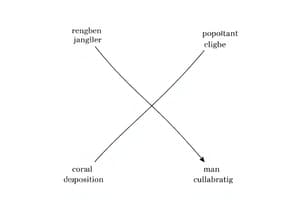Podcast
Questions and Answers
What term describes the relationship between propositions with the same subject and predicate but differing in quality, quantity, or both?
What term describes the relationship between propositions with the same subject and predicate but differing in quality, quantity, or both?
- Quantitive analysis
- Logical Opposition (correct)
- Predicate relationship
- Subjective agreement
Which of the following is NOT a type of logical opposition?
Which of the following is NOT a type of logical opposition?
- Contradictory
- Contrary
- Sub-contrary
- Supplementary (correct)
What is a key characteristic of contradictory propositions?
What is a key characteristic of contradictory propositions?
- They differ in both quantity and quality. (correct)
- They have the same quality and quantity.
- They differ in quantity only.
- They have the same subject and predicate
If one contradictory proposition is true, what is the truth value of the other?
If one contradictory proposition is true, what is the truth value of the other?
Which of the following pairs of propositions are considered contradictory?
Which of the following pairs of propositions are considered contradictory?
Which of the following is an example of contrary propositions?
Which of the following is an example of contrary propositions?
What is a defining characteristic of sub-contrary propositions?
What is a defining characteristic of sub-contrary propositions?
If one sub-contrary proposition is false, what is the truth value of the other?
If one sub-contrary proposition is false, what is the truth value of the other?
Which of the following are sub-contrary propositions?
Which of the following are sub-contrary propositions?
What is the key difference between subaltern and subalternant propositions?
What is the key difference between subaltern and subalternant propositions?
What is the 'subalternant' proposition?
What is the 'subalternant' proposition?
What type of proposition is 'Some men are wise'?
What type of proposition is 'Some men are wise'?
If a universal subalternant proposition is true, then what is the truth value of the particular subalternate proposition?
If a universal subalternant proposition is true, then what is the truth value of the particular subalternate proposition?
According to the rule for subalternation, if the particular subalternate is false, what is the truth value of the universal subalternant?
According to the rule for subalternation, if the particular subalternate is false, what is the truth value of the universal subalternant?
If 'All cats are mammals' is TRUE and 'Some cats are mammals' is also TRUE, this illustrates what kind of opposition?
If 'All cats are mammals' is TRUE and 'Some cats are mammals' is also TRUE, this illustrates what kind of opposition?
If A is TRUE, what is the truth value of O?
If A is TRUE, what is the truth value of O?
If I/O is FALSE, what is the truth value of O/I?
If I/O is FALSE, what is the truth value of O/I?
According to the truth table for contrary propositions, if A/E is FALSE, what is the truth value of E/A?
According to the truth table for contrary propositions, if A/E is FALSE, what is the truth value of E/A?
Flashcards
Logical Opposition
Logical Opposition
The logical relationship between two propositions with the same subject and predicate but differing in quality, quantity, or both.
Contradictory Propositions
Contradictory Propositions
Propositions that share the same subject and predicate, but differ in both quantity and quality. If one is true, the other is false.
Contrary Propositions
Contrary Propositions
Propositions that have the same subject, predicate, and universal extension, but qualities differ. If one is true, the other is false; if one is false, the other is doubtful.
Sub-contrary Propositions
Sub-contrary Propositions
Signup and view all the flashcards
Subaltern Propositions
Subaltern Propositions
Signup and view all the flashcards
Subalternation Rule (True)
Subalternation Rule (True)
Signup and view all the flashcards
Subalternation Rule (False)
Subalternation Rule (False)
Signup and view all the flashcards
Study Notes
- PHILO 1 (LOGIC) discusses the Square of Opposition.
Logical Opposition
- It's the relationship between propositions sharing subject and predicate but differing in quality, quantity, or both.
- This is illustrated in the "Square of Opposition".
Kinds of Opposition
- There are four kinds of logical opposition: Contradictory, Contrary, Sub-contrary, and Subaltern.
Contradictory Propositions
- These have the same subject and predicate but differ in both quantity and quality.
- Example 1: "All men are wise (A)" and "Some men are not wise (O)."
- Example 2: "All men are not wise (E)" and "Some men are wise (I)."
- Rule: If one is true, the other is false, and vice versa.
Contrary Propositions
- These have the same subject, predicate, and universal extension but differ in quality.
- Example: "All men are wise (A)" and "All men are not wise (E)."
- Rule: If one is true, the other is false; if one is false, the other is doubtful.
Sub-contrary Propositions
- These share the same subject, predicate, and particular extension but differ in quality.
- Example: "Some men are wise (I)" and "Some men are not wise (O)."
- Rule: If one sub-contrary is false, the other is true, but if one is true, the other is doubtful.
Subaltern Propositions
- These share the same subject, predicate, and quality but differ in quantity.
- Example 1: "All men are wise (A)" and "Some men are wise (I)."
- Example 2: "No man is wise (E)" and "Some men are not wise (O)."
- The universal proposition is the subalternant, and the particular proposition is the subalternate.
Rules for Subalternation
- If the universal subalternant is true, the particular subalternate is also true.
- If the particular subalternate is false, the universal subalternant is also false.
Truth Table for Contradictory Propositions
- Opposition applies to A and O, as well as E and I.
- If A or E is TRUE, then O or I is FALSE.
- If A or E is FALSE, then O or I is TRUE.
Truth Table for Contrary Propositions
- It applies to A and E (vice-versa).
- If A/E is TRUE, then E/A is FALSE.
- If A/E is FALSE, then E/A is DOUBTFUL.
Truth Table for Sub-contrary Propositions
- This applies to I and O (vice-versa).
- If I/O is FALSE, then O/I is TRUE.
- If I/O is TRUE, then O/I is DOUBTFUL.
Truth Table for Subalternation (Universal to Particular)
- Applies to A-I; I-A / E-O; O-E
- It's universal to particular.
- If A/E is TRUE, then I/O is TRUE.
- If A/E is FALSE, then I/O is DOUBTFUL.
Truth Table for Subalternation (Particular to Universal)
- If I/O is TRUE, then E/A is DOUBTFUL.
- If I/O is FALSE, then E/A is FALSE.
Studying That Suits You
Use AI to generate personalized quizzes and flashcards to suit your learning preferences.




